Health Insurance
Nearly 70% of Americans Would Wear a Fitness Tracker/Smartwatch for Discounted Health Insurance
Fitness trackers — many of which come in the form of smartwatches — provide wearers with valuable information that can help them improve their health. You can track your steps, sleep quality and heart rate to learn what areas of your health need improvement. With some fitness trackers, you can even gain insight into how your body responds to stress.
And nearly 7 in 10 Americans would be willing to wear a tracker if it could get them a discount on their health insurance, according to the latest ValuePenguin survey of more than 1,500 consumers. This survey also looks at who owns smartwatches and how they utilize them and compares how smartwatch users rate their health versus those who don’t wear one.
Key findings
- 69% of Americans would be willing to wear a fitness tracker if it meant a health insurance discount. That includes 46% who would take it further and share the data with their insurer for the discount. Meanwhile, 55% who don’t use a smartwatch would be willing to wear one for a discount, including 35% who would share the data.
- 45% of Americans already regularly wear smartwatches such as Apple Watches (20%) or Fitbits (16%). The devices are popular with Gen Zers (70%), millennials (57%) and women (51%).
- The vast majority (92%) of smartwatch wearers use them for health and fitness reasons, and 88% say their watch has helped them achieve a fitness goal. Getting regular exercise (48%) and increasing steps (34%) are the most common achievements cited by smartwatch users.
- Smartwatch users value the biometric data their wearables collect, with 42% having talked to their doctor about their info on topics such as heart rate and sleep. This is especially common among Gen Zers (56%) and millennials (46%).
- Smartwatch users get more exercise than those who don’t wear one. Those who regularly wear a smartwatch exercise an average of 4.3 days a week, compared with 3.0 days for nonusers. Smartwatch users also claim to be in slightly better health than those without a smartwatch, rating their health at an average of 3.5 on a five-point scale, while those without rated themselves at 3.3.
Nearly 7 in 10 Americans would wear fitness tracker to get health insurance discount
Even if insurance companies offer discounts and other incentives in exchange for smartwatch and fitness tracker data, the question remains whether that’s a trade that interests consumers.
Almost 7 in 10 (69%) Americans report they would wear a fitness tracker such as an Apple Watch or Fitbit if their health insurance provider would give them a discount on their insurance policy. Within this group, 46% are comfortable sharing their data with their health insurance provider if it leads to a discount. The other 22% aren’t interested if they have to share the data.
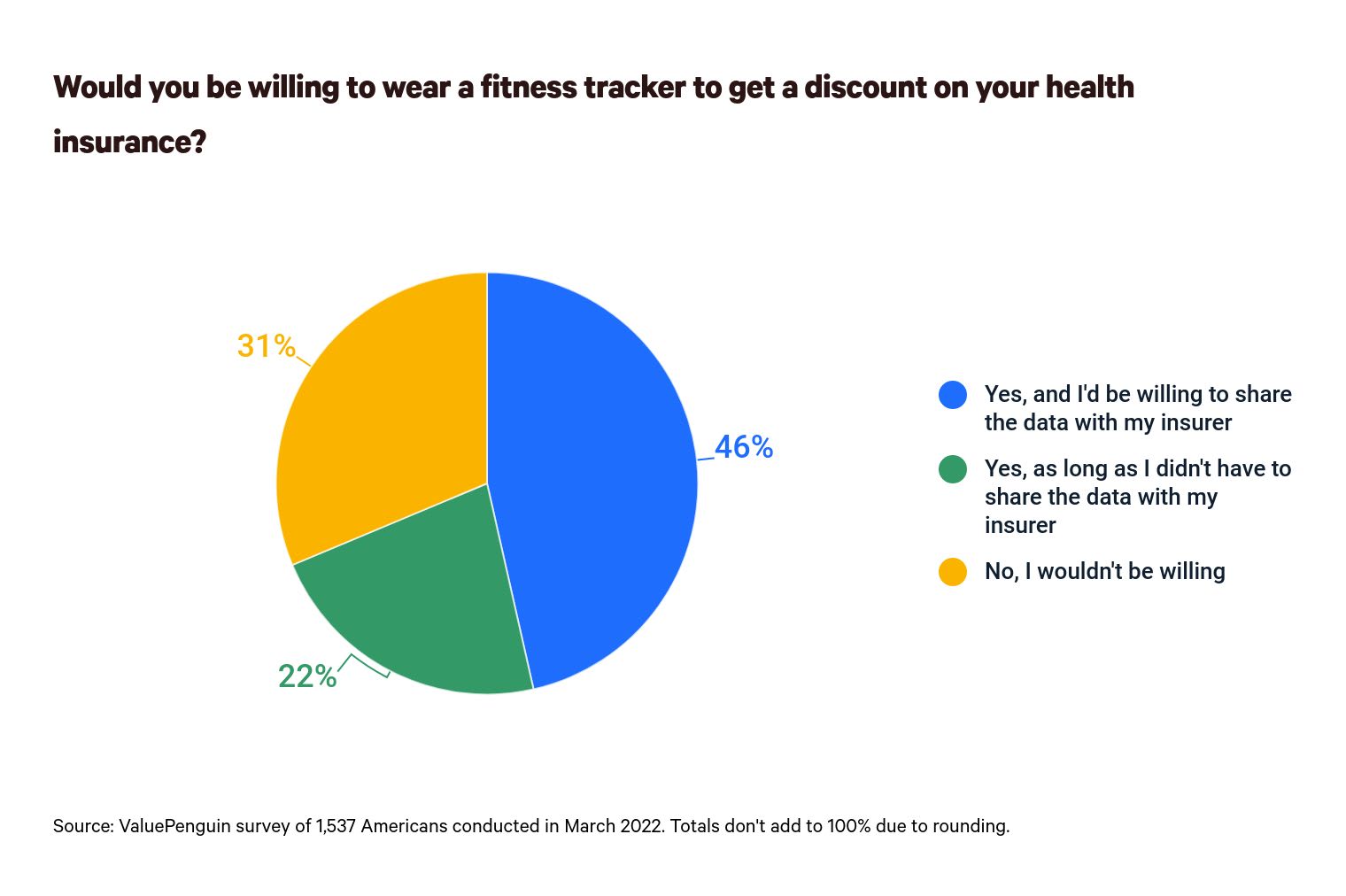
Nearly half of men (47%) and women (46%) would be fine with wearing a tracker and sharing that data. Meanwhile, just 40% of those with an annual household income of $35,000 or less say they would wear one and give the data to their health insurance company, versus 58% of those who earn $100,000 or more.
So, is giving up privacy a fair trade for a discount? Robin Townsend, ValuePenguin health and life insurance expert, sees this trade-off as a win for both parties.
"Wearing a fitness tracker — and getting a health insurance discount for it — is a huge positive," Townsend says. "A tracker increases your awareness of your health habits, which can improve your overall well-being."
She believes insurance companies would do well to encourage more fitness tracker use.
"When companies support the use of fitness trackers, consumers become more engaged in maintaining good health," Townsend says. "And while financial incentives help to build interest, interactive fitness apps encourage even more customer engagement."
Among those who don’t already wear a fitness tracker or smartwatch, 55% say they’d be willing to do so if they could get a health insurance discount — including 35% who would share the data.
The survey also asked respondents about the types of people who should get these discounts if they share the info:
- 30% cite meditation app users
- 27% cite people who get the recommended amount of exercise
- 26% cite people who track their nutrition intake
- 24% cite people who get the recommended amount of steps
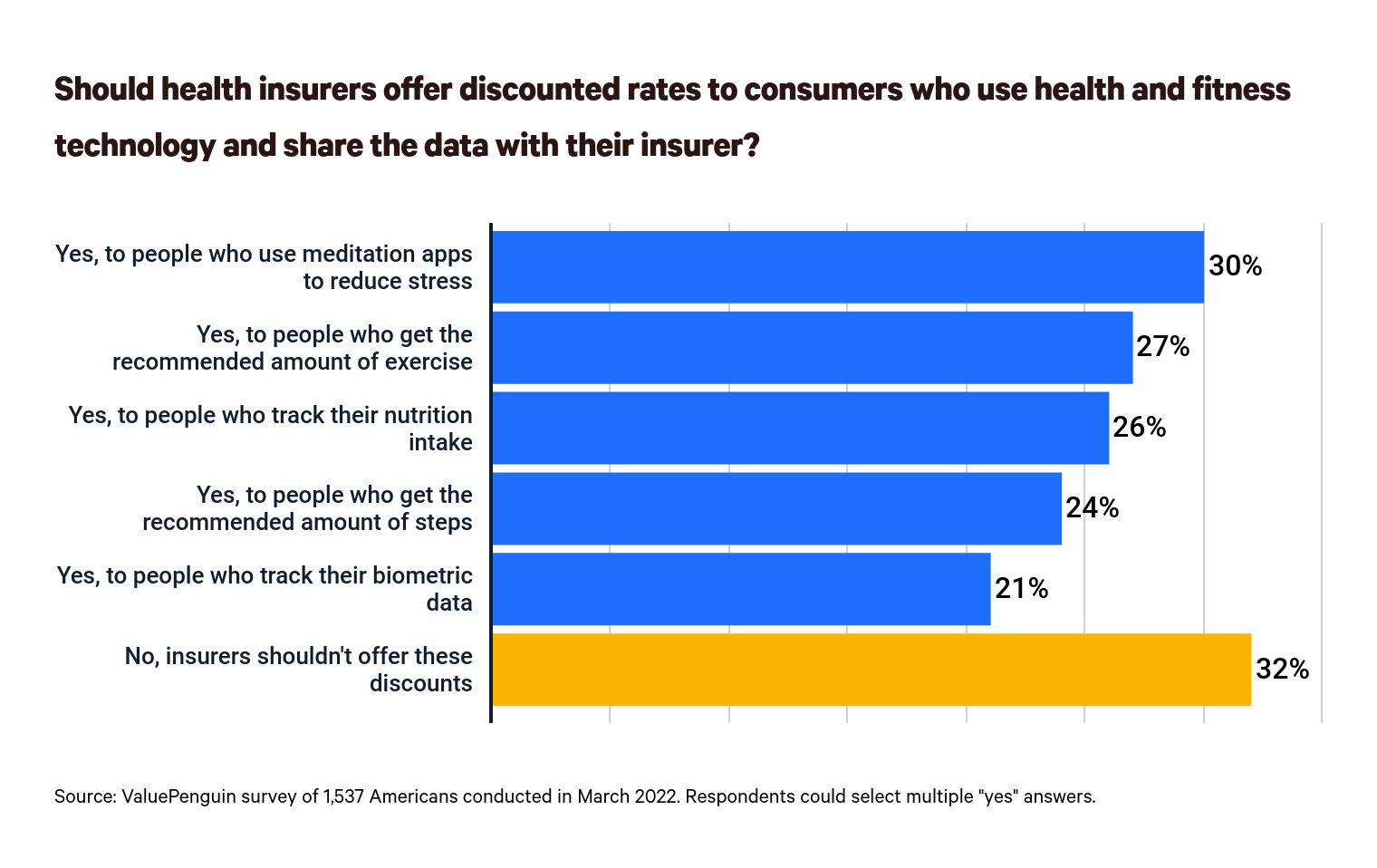
Insurance companies that reward consumers with health discounts
"Better fitness reduces health care costs, which is good for both the customer and the insurer," Townsend says.
It’s easy to see how this arrangement has the potential to benefit both the customer and insurer. The following companies help consumers secure discounts on products and services that make it easier to lead a healthy life.
- Blue365. This free BlueCross BlueShield program offers fitness and wellness discounts to members, such as saving up to 33% on Fitbit devices.
- Cigna Healthy Rewards Incentive. This program provides online coaching to help you meet your health goals. You can earn points for participating in select health and wellness activities. After earning 1,000 points, you can earn a $50 incentive (up to a maximum of $500).
- ChooseHealthy. Kaiser Permanente’s ChooseHealthy program makes it possible to save on activity trackers from brands like Fitbit and Garmin.
Some life insurance companies also offer related discounts. For example, through the John Hancock Vitality program, you can save up to 25% on your premium for making healthy choices. You can also get an Apple Watch for as little as $25 plus tax or a Fitbit for free.
Who wears smartwatches, why they wear them and how they’re helping with fitness goals
Now, let’s take some time to examine who’s wearing smartwatches and fitness trackers and how they’re capitalizing on the technology that is at hand.
Just less than half of Americans (45%) already own a smartwatch, which can act as a fitness tracker. Those who have an annual household income of $75,000 to $99,999 are much more likely (58%) to own a smartwatch than those who have a household income of less than $35,000 (31%) — likely because these watches can cost hundreds of dollars.
Younger generations are also much more likely to wear smartwatches than older ones. While 70% of Gen Z (ages 18 to 25) consumers wear a smartwatch, only 36% of Gen X (ages 42 to 56) and 25% of baby boomer (ages 57 to 76) consumers wear them.
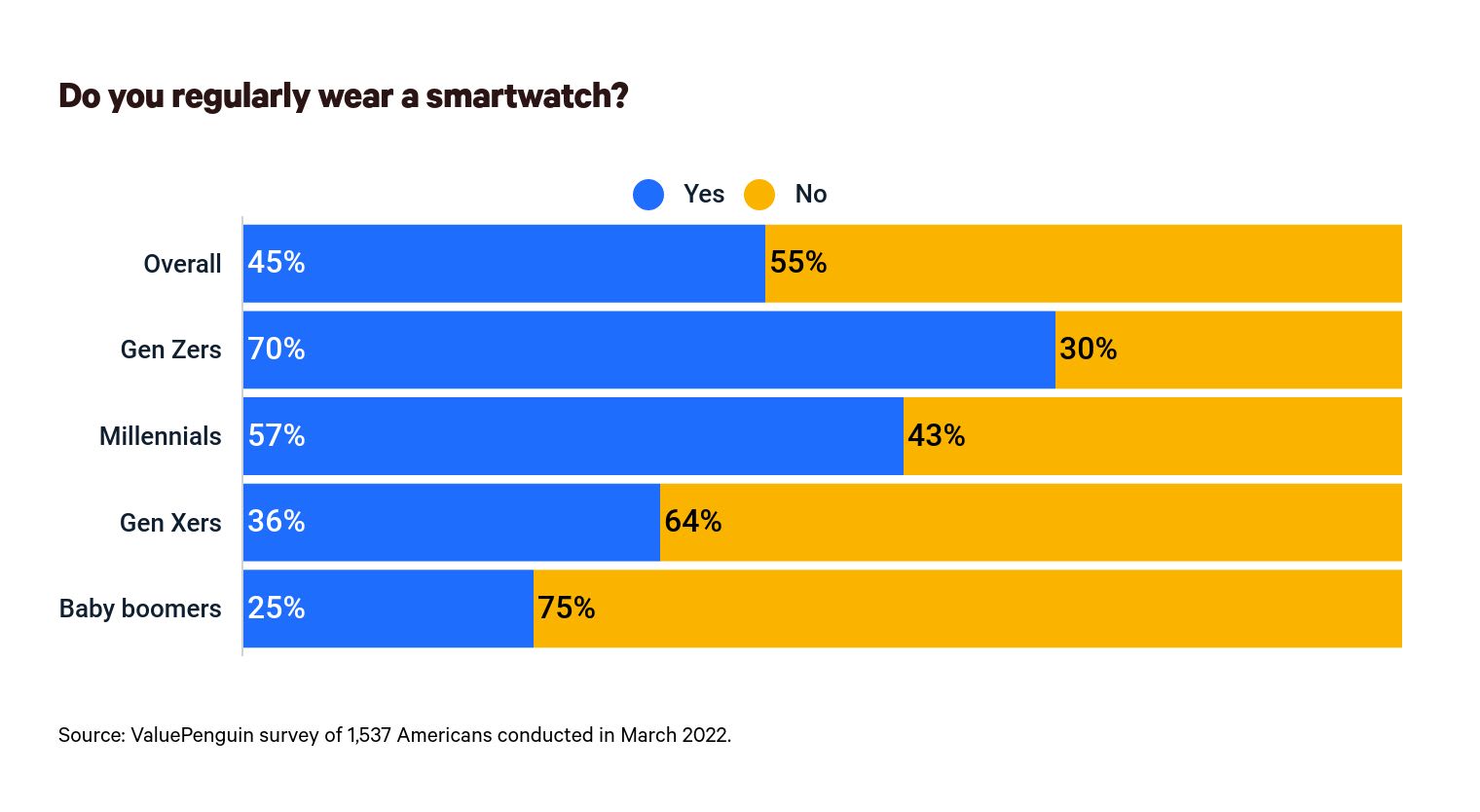
More than 9 in 10 (92%) smartwatch wearers use them for health or fitness reasons, with 88% saying their watch has helped them achieve a fitness goal.
The goals in question? Getting regular exercise (48%) and increasing steps (34%) are most commonly cited.
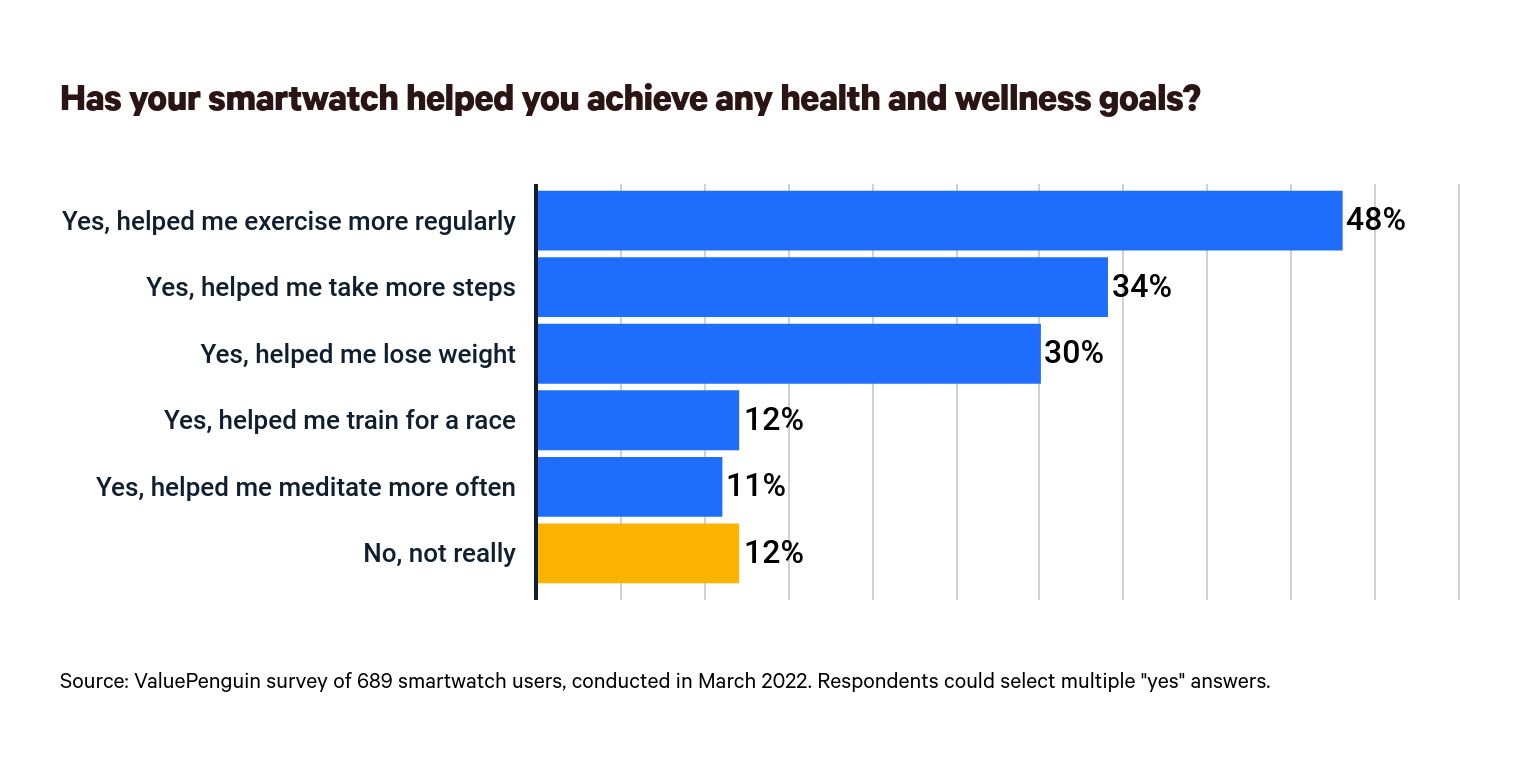
Alongside tracking exercise and movement, users also take advantage of the ability to increase accountability (22%), engage in some harmless competition with loved ones (13%) and track food or water intake (12%), among other things.
42% of smartwatch wearers have talked to their doctor about their data
More than 4 in 10 smartwatch wearers (42%) have taken advantage of the data collected by their smartwatches and have talked to their doctor about it on topics such as heart rate and sleep. Gen Zers (56%) and millennials (46%) are especially likely to consult their doctor on their findings. And men (47%) are more likely to take this data to their doctor than women (38%).
Townsend recommends taking this data to your doctor.
"The goal of a fitness tracker is to increase awareness of your health and health-related decisions, and using your tracker’s data can help frame a conversation with your health care provider," Townsend says. "For example, you may want to tell your doctor when your tracker shows changes in your heart rate, or when your activity level increases but you’re still not reaching your fitness goals."
One major perk of wearing a smartwatch is that it can help you build healthier daily habits. In fact, half of smartwatch users generally get up each hour and move around after being nudged.
Smartwatch users get more exercise than those who don’t wear one
Those considering investing in a smartwatch will be happy to hear that they tend to motivate users to prioritize their health fairly effectively.
Overall, smartwatch users tend to get more exercise than those who don’t wear one of the high-tech gadgets. Regular smartwatch wearers exercise an average of 4.3 days a week, compared with 3.0 days for nonusers. Here’s a day-by-day breakdown:
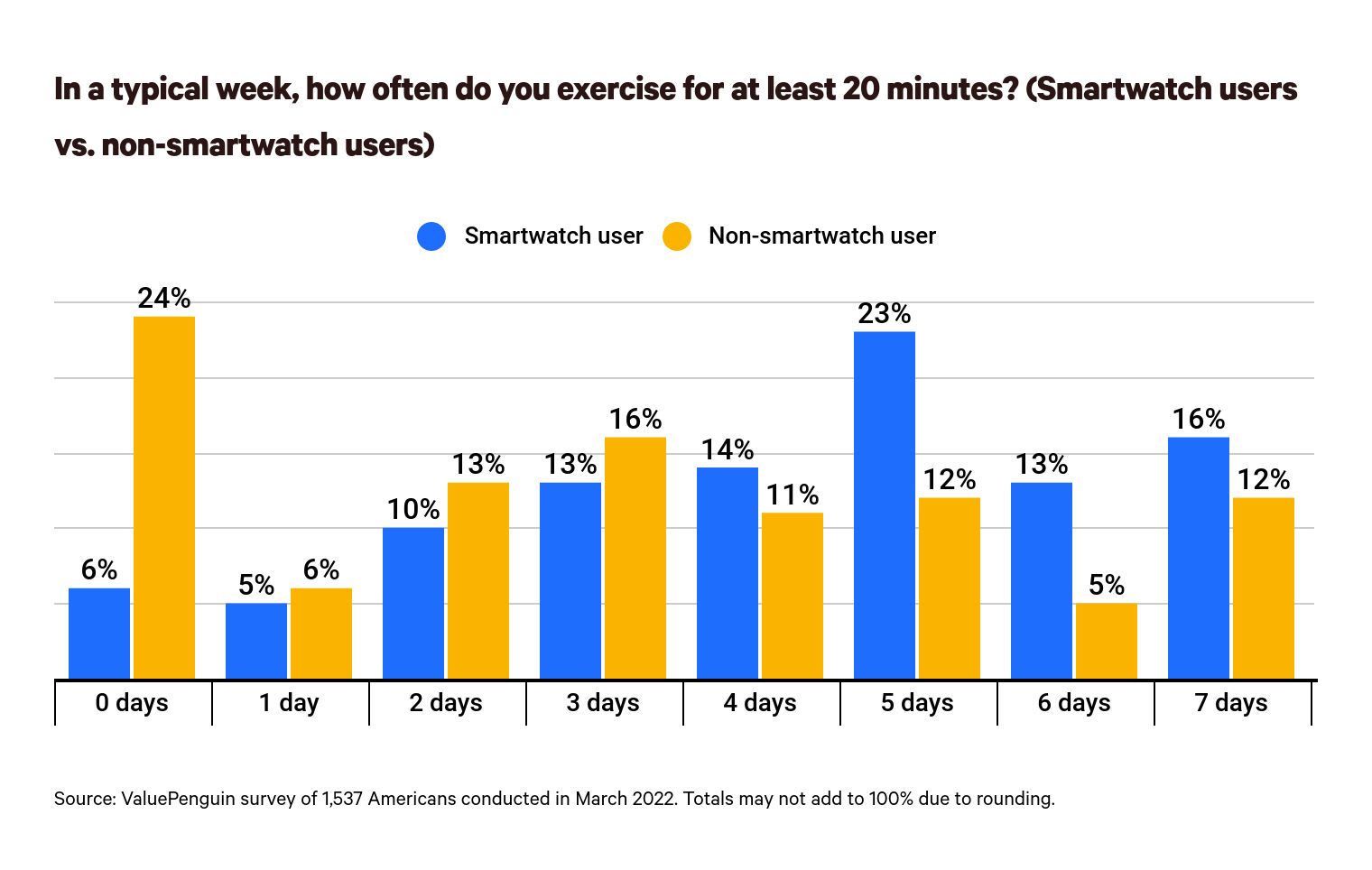
As we’ve noted, there’s a wide variety of smartwatches and fitness trackers that can meet different style and budgetary preferences. And it looks like there’s a bit of competition between two of the more popular devices: Apple Watch users get slightly more exercise than Fitbit users each week (4.4 days versus 4.3 days).
Lastly: Do smartwatch users feel like they’re getting a lot out of wearing these devices? It looks like they really can move the needle healthwise (or at least the perception of having better health).
Smartwatch users report they believe they’re in slightly better health than those without a smartwatch, rating their health at an average of 3.5 on a five-point scale. Those without a smartwatch rated themselves at 3.3.
Methodology
ValuePenguin commissioned Qualtrics to conduct an online survey of 1,537 consumers March 17-24, 2022. The survey was administered using a nonprobability-based sample, and quotas were used to ensure the sample base represented the overall population. All responses were reviewed by researchers for quality control.
We defined generations as the following ages in 2022:
- Generation Z: 18 to 25
- Millennial: 26 to 41
- Generation X: 42 to 56
- Baby boomer: 57 to 76
While the survey also included consumers from the silent generation (those 77 and older), the sample size was too small to include findings related to that group in the generational breakdowns.
